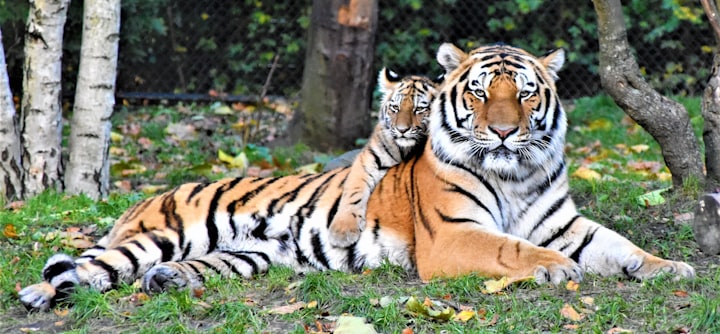Tiger
The tiger, also known as Panthera tigris, is the largest cat species on the planet. It is an apex predator and is feared by many other animals. Tigers are famous for their distinctive orange and black striped fur, and they are often depicted in artwork, folklore, and pop culture. They are native to Asia and are found in a range of habitats, including tropical forests, grasslands, and swamps.
Physical Characteristics
Tigers are the largest members of the cat family, with males weighing up to 600 pounds and females up to 400 pounds. They have a muscular build, with powerful legs and sharp claws that they use for hunting and climbing. Tigers have a unique pattern of stripes that is as individual as a human fingerprint, with no two tigers having the same pattern.
Tigers have excellent eyesight and hearing, which allows them to detect prey from a distance. They are also strong swimmers and can swim across rivers and lakes to hunt for prey or to travel to new territories.
Habitat and Distribution
Tigers are found in a wide range of habitats across Asia, including tropical forests, grasslands, swamps, and savannas. They prefer areas with dense vegetation and a steady supply of water, such as near rivers or lakes. The specific habitat that tigers occupy varies depending on the subspecies and the country in which they live.
Tigers are distributed across 13 countries in Asia, including Bangladesh, Bhutan, Cambodia, China, India, Indonesia, Laos, Malaysia, Myanmar, Nepal, Russia, Thailand, and Vietnam. However, their distribution has become severely fragmented due to habitat loss, poaching, and other threats. In the past, tigers were found in much larger numbers and over a much broader range, but their populations have declined dramatically in recent years.
India is home to the largest population of wild tigers, with an estimated 70% of the global population residing there. Other countries with significant tiger populations include Russia, Indonesia, and Malaysia. However, many countries with historical tiger ranges, such as Cambodia, Laos, and Vietnam, have reported very few tigers or no tigers at all in recent years.
Efforts to protect tiger habitats are ongoing, with many conservation organizations working to protect and restore degraded ecosystems. Protected areas, such as national parks and wildlife sanctuaries, provide critical habitat for tigers and are essential for their survival. However, the protection of these areas alone is not enough, and concerted efforts are needed to address the underlying drivers of habitat loss, such as human development, infrastructure, and agriculture.
Conservation Status
Despite being one of the most iconic and beloved animals on the planet, tigers are currently endangered. The global population of tigers has declined dramatically in the past century, with only around 4,000 wild tigers remaining. Habitat loss and poaching are the two main threats facing tigers today. Tigers are hunted for their bones, skins, and other body parts, which are used in traditional Chinese medicine and as luxury items.
Efforts to protect tigers are ongoing, and there are several conservation organizations working to save these magnificent animals. One such organization is the World Wildlife Fund (WWF), which works to protect tiger habitat, stop poaching, and reduce human-tiger conflict.
Behavior and Diet
Tigers are solitary animals and are typically active during the night. They are territorial and will defend their territory against other tigers. Tigers are also excellent hunters, and they prey on a wide variety of animals, including deer, wild pigs, and buffalo. They have been known to attack humans in rare cases, usually when their habitat has been destroyed and they have nowhere else to go.
Tigers are apex predators, meaning they are at the top of the food chain in their ecosystem. They play an essential role in maintaining the balance of their habitat, and their presence helps to keep prey populations in check.
Cultural Significance
Tigers have played an important role in the cultures of many Asian countries for thousands of years. In Hinduism, the goddess Durga is often depicted riding a tiger. In Chinese culture, the tiger is one of the 12 animals of the Chinese zodiac and is seen as a symbol of power and courage. Tigers have also been depicted in art, literature, and popular culture around the world.
Conclusion
The tiger is an impressive and iconic animal that plays a vital role in the ecosystems of Asia. Despite their cultural significance and ecological importance, tigers are currently endangered due to habitat loss and poaching. Conservation efforts are ongoing to protect these majestic animals, and it is essential that we continue to support these efforts to ensure the survival of tigers in the wild. By working together, we can ensure that future generations have the opportunity to experience the wonder and beauty of the magnificent tiger.







Comments
There are no comments for this story
Be the first to respond and start the conversation.